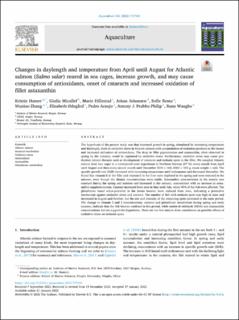| dc.contributor.author | Hamre, Kristin | |
| dc.contributor.author | Micallef, Giulia | |
| dc.contributor.author | Hillestad, Marie | |
| dc.contributor.author | Johansen, Johan | |
| dc.contributor.author | Remø, Sofie c | |
| dc.contributor.author | Zhang, Wuxiao | |
| dc.contributor.author | Ødegård, Elisabeth Rasmussen | |
| dc.contributor.author | Araujo, Hernandez Pedro W | |
| dc.contributor.author | Prabhu, P. Antony Jesu | |
| dc.contributor.author | Waagbø, Rune | |
| dc.date.accessioned | 2022-07-13T12:06:44Z | |
| dc.date.available | 2022-07-13T12:06:44Z | |
| dc.date.created | 2022-02-21T13:48:20Z | |
| dc.date.issued | 2022 | |
| dc.identifier.citation | Aquaculture. 2022, 551 . | en_US |
| dc.identifier.issn | 0044-8486 | |
| dc.identifier.uri | https://hdl.handle.net/11250/3005048 | |
| dc.description.abstract | The hypothesis of the present study was that increased growth in spring, stimulated by increasing temperature and daylength, leads to oxidative stress in Atlantic salmon with accumulation of oxidation products in the tissues and increased utilization of antioxidants. The drop in fillet pigmentation and astaxanthin, often observed in spring by the industry, could be explained by oxidative stress. Furthermore, oxidative stress may cause production related diseases such as development of cataracts and melanin spots in the fillet. We sampled Atlantic salmon from two cages in a commercial scale experiment in Northern Norway (67°N), every month from April until August and then every second month until December (510 ± 160–3060 ± 510 g, mean weight ± std). The specific growth rate (SGR) increased with increasing temperature until midsummer and decreased thereafter. We found that vitamin E in the fillet and vitamin C in the liver were depleted in the spring and were restored in the autumn, even though the dietary concentrations were stable. Astaxanthin concentration in the muscle was constant during the spring and summer and increased in the autumn, concomitant with an increase in astaxanthin supplementation. Cataract increased from zero in May until July, when 90% of the fish were affected. The glutathione based redox-potential in the lenses became more reduced from June, indicating a protective mechanism against oxidative stress and cataract. The number of fish with melanin spots was high in June and decreased in August and October, but the size and intensity of the remaining spots increased in the same period. The change in vitamin C and E concentrations, cataract and glutathione metabolism during spring and early summer, indicate that the fish became oxidized in this period, while malon-di-aldehyde (MDA) and astaxanthin concentrations did not support the hypothesis. There are too few data to draw conclusions on possible effects of oxidative stress on melanin spots. | en_US |
| dc.language.iso | eng | en_US |
| dc.title | Changes in daylength and temperature from April until August for Atlantic salmon (Salmo salar) reared in sea cages, increase growth, and may cause consumption of antioxidants, onset of cataracts and increased oxidation of fillet astaxanthin | en_US |
| dc.title.alternative | Changes in daylength and temperature from April until August for Atlantic salmon (Salmo salar) reared in sea cages, increase growth, and may cause consumption of antioxidants, onset of cataracts and increased oxidation of fillet astaxanthin | en_US |
| dc.type | Peer reviewed | en_US |
| dc.type | Journal article | en_US |
| dc.description.version | publishedVersion | en_US |
| dc.source.pagenumber | 12 | en_US |
| dc.source.volume | 551 | en_US |
| dc.source.journal | Aquaculture | en_US |
| dc.identifier.doi | 10.1016/j.aquaculture.2022.737950 | |
| dc.identifier.cristin | 2004125 | |
| dc.relation.project | Fiskeri- og havbruksnæringens forskningsfinansiering: 901441 | en_US |
| cristin.ispublished | true | |
| cristin.fulltext | original | |
| cristin.qualitycode | 2 | |
